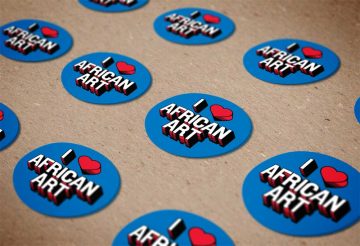
“Wind Sculptures . . . capture the wind to produce something tangible out of the intangible.”
—Yinka Shonibare MBE, 2014

Yinka Shonibare MBE
b. 1962, England
Wind Sculpture VII (Detail)
2016
Steel armature with hand-painted fiberglass resin cast and gold leaf
Museum purchase with funds from Amelia Quist-Ogunlesi and Adebayo Ogunlesi and the Sakana Foundation, 2016-11-1
Wind Sculpture VII is the first sculpture installed permanently in front of the Smithsonian National Museum of African Art. This unique, gold-leaf version of Shonibare’s Wind Sculptures series evokes the sails of ships that have crossed the Atlantic and other oceans, connecting nations through the exchange of ideas, products, and people. In its form, it captures histories that can be inspiring or brutal, but always complex. It suggests that the opening of the seas led not only to the slave trade and colonization, but also to the dynamic contributions of Africans and African heritage worldwide. Using yellow, blue, rose, and gold, Shonibare celebrates the African men, women, and children who have shaped the United States, Great Britain, and other nations of today and for the future.
Yinka Shonibare MBE describes himself as a “postcolonial hybrid.” His stylish and sumptuous works of art range from paintings and photographs to headless mannequins and video projection, and have now expanded to include outdoor sculpture. All, however, incorporate the patterns of vibrant textiles often referred to as “African print” cloth. These textiles speak to the global networks that link us all: they are based on Indonesian batiks, manufactured in the Netherlands and Great Britain, and named, worn, and sold across western Africa. For Shonibare, these textiles become a catalyst with which to rethink history, political and economic entanglements, and the choices we are making that effect our future.

Shonibare was born in the United Kingdom in 1962 and moved to Lagos, Nigeria, at the age of three. He returned to London to receive his MFA from Goldsmiths College, a part of the “Young British Artists” generation. He gained notoriety on the international stage via his commission for Okwui Enwezor’s Documenta 10 and was a Turner Prize nominee in 2004. In 2005 he was awarded the decoration of Member of the Most Excellent Order of the British Empire, a title that he officially added on his professional name. His works were featured in the 52nd Venice Biennale and a major mid-career survey toured from 2008–09. In 2011, the artist’s sculpture Nelson’s Ship in a Bottle was selected for Trafalgar Square’s prestigious commission series. Shonibare’s works are included in many prestigious public collections spanning the globe. He currently lives and works in London’s East End.
Share your best shots of Wind Sculpture on social media, and don’t forget to tag us!
@nmafa #WindSculpture #YinkaShonibare
Are you excited as we are about this new art addition? Stay in the loop about this and more upcoming events with our e-newsletter.
